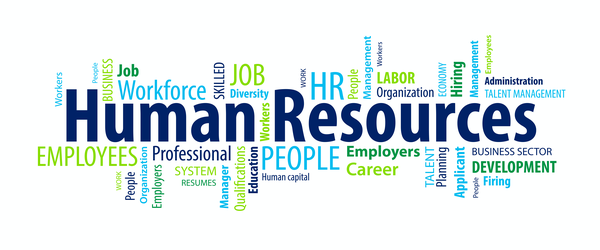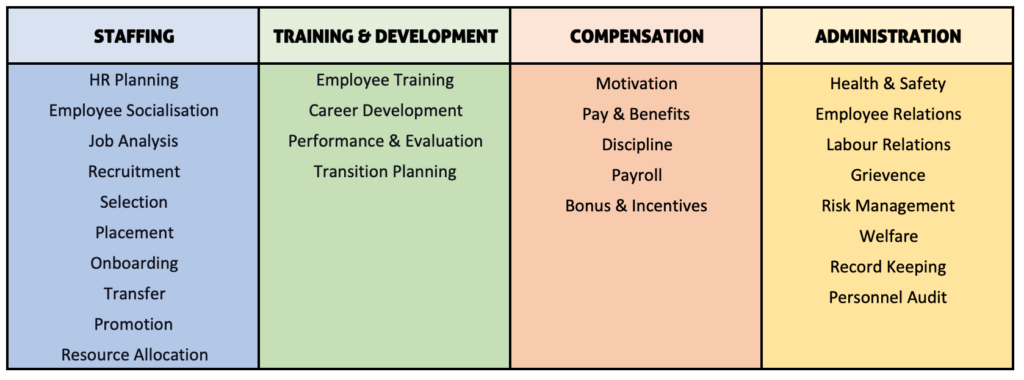
As a working definition, Human Resources (HR) is the process of managing a workforce to improve productivity and workplace happiness. Its purpose is to improve people’s capability while also fostering commitment through positive practices.
But human resources is an incredibly wide-ranging subject that’s difficult to pin down to a single definition.
In today’s article, we’ll be looking at the key functions and processes of a modern HR department.
We’ll be covering:
- What are the four key areas of Human Resources?
- Staffing,
- Training and development
- Compensation
- Administration
Let’s get started!
What are the four key areas of Human Resources?
Human Resources involves cultural, social, and personnel tactics to cover all areas of a person’s work life, from onboarding and training to workplace development and discipline. To understand it better, it’s useful to break it down into the four key areas of people management.
The 4 key areas of human resources are
- Staffing,
- Training and development,
- Compensation,
- Administration.
These four areas cover all parts of human resources, from staff planning and recruitment to payroll and risk management. A human resources employee must be well versed in all areas in order to provide effective staff management.
Of course, in many businesses, management take on different areas of human resources management. Whether this is staff motivation or disciplinary proceedings, various responsibilities are shared amongst employees outside of the human resources department.

Staffing
Staffing is exactly what it sounds like: the management of people within a business. This excludes training but rather focuses on effectively hiring and utilizing a strong workforce in order to get the most out of employees. Here is a list of exactly what staffing covers in the world of human resources.
1. HR planning
Simply put, HR planning is the continual process of planning and revising the way employees are utilized within a business to maximize efficiency.
2. Employee socialization
Social employees are happy employees, so this area covers “fun” aspects of work, such as games and lunches, to improve workplace motivation.
3. Job analysis
This is the process of understanding the responsibilities and duties of a particular role within a business. It helps to determine the skills and experience needed for said role. These then get documented and are often used within the recruitment process.
4. Recruitment
Recruitment covers the advertising of jobs and the process of hiring qualified and effective staff. This is usually backed up through a step-by-step process that takes requirements, criteria etc to lead to the best candidate.
5. Selection
Similar to recruitment, selection is the process of identifying the most qualified candidates for a role through tests and interviews.
6. Placement
Placement involves putting the best employee in the best role to maximize their productivity.
7. Onboarding
This process refers to introducing a new employee to a business, including training and reference to workplace practices.
8. Transfer
Transfer means changing someone’s role within an organization. This might involve retraining, change in pay, or change in employment status.
9. Promotion
Promotion refers to an employee moving up the business ladder, such as from team member to management.
10. Resource allocation
Resource allocation is the management of people, funds, and time to ensure everything is covered and running smoothly.
Training and development
Training and development usually centers around building and advancing an employee’s role within the business. Development is key for employee retention, as it reduces the chances of them looking elsewhere for a more fulfilling role.
1. Employee training
All employees receive some level of training for their role, which refers to them understanding their functional role within an organization. The HR function will usally have some level of co-ordination within that process.
2. Career development
Career development is the process of building on someone’s current training to move them upwards in the organization, such as promotion into a management role.
3. Performance evaluation
Performance evaluation covers how well an employee has worked over a set period, along with goals for improvement in the future. The Human Resources function usually identify and deploy the process that is utilized and co-ordinate and store the information captured as part of the process.
4. Transition planning
This process involves ensuring an employee is in the right position to move between roles, or to exit the company properly.
Compensation
Compensation is the process of managing an employee’s financial return for their work, as specified in their contract. Along with wages it covers benefits, but also procedures for breach of their contract, such as disciplinary hearings and termination of employment.
1. Motivation
This is the process of building commitment in employees by understanding why they might not be happy and how to improve these aspects.
2. Pay and benefits
Pay is the amount of money an employee is given for their work, while benefits cover compensation that isn’t money (free meals, free parking, etc.).
3. Discipline
If an employee breaches terms of their contract, they are disciplined. The process involves investigations and meetings, and can end in contract termination.
4. Payroll
Payroll covers the employees who receive money from the company. This will usually also involve taxes and social contributions paid by an employee from their paychecks, such as employment tax and national insurance.
5. Bonus and incentives
Both are considered financial motivation, and might be given when employees hit targets or fulfil other workplace goals.
Administration
Human resources administration is basically everything not covered in the above areas. It involves ensuring a standard of workplace safety and experience among staff within the organization, including risk management and labour relations. Importantly too, it covers the management and retention of all records relating to the HR department.
1. Health and safety
Health and safety ensure employees work within an environment free of risk, such as injury and accident.
2. Employee relations
This process ensures the values of employees are aligned with the business’s values to create a positive working relationship.
3. Labour relations
Labour relations cover decisions relating to working conditions, safety, etc. They often involve labour unions as well as employees.
4. Grievance
Grievances are the formal process of how an employee raises a complaint about workplace practices, effectively the reverse of a disciplinary hearing.
5. Risk management
This involves assessing potential hazards in the workplace and suggesting solutions to minimize accidents and injury.
6. Welfare
This refers to the overall health of employees relating to work, such as physical and mental health to ensure an effective workforce.
7. Record keeping
Record keeping is just that: keeping business records on pay, employment, and so on.
8. Personnel audit
This involves reviewing HR and other departments and their policies to see if improvements can be made and that everything is functioning within the law.
Summary
As you can see, the role of Human resources is rich and diverse.
As a function, it continues to evolve, finding new ways to provide value to the organization and act as a key enabler for competitiveness.
What do you think of Human Resources? How does your HR team add value? Got feedback? Think we’ve missed any crucial functions? We’d love to hear from you – as usual, you can tweet us or get in contact via the feedback section below.
This article is part of our Human Resources Guide.